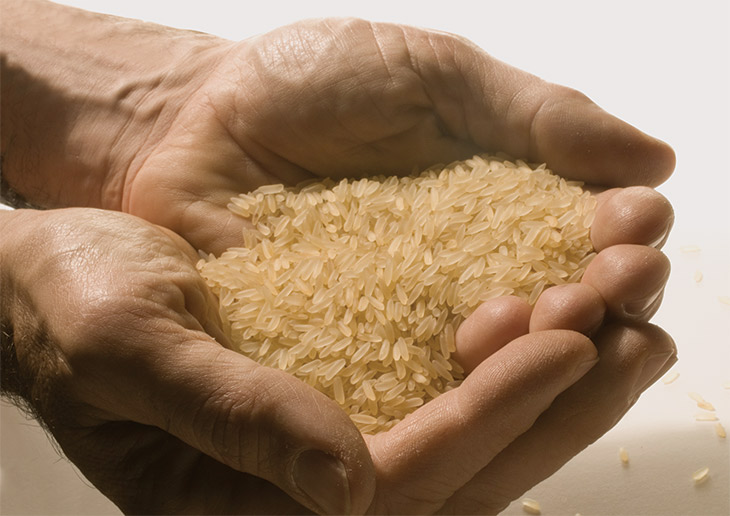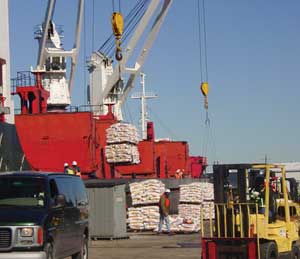When Jamie Warshaw learned about the earthquake that devastated Haiti on Jan. 12, 2010, he thought, “You couldn’t pick a worse country for a disaster.” As a commercial rice miller in Lousiana, he had visited Haiti several times and was keenly aware of the nation’s poverty and challenging infrastructure.
Thus, when the U.S. government offered to send food aid to the earthquake survivors as soon as possible, Warshaw was quick to respond. The Louisiana rice industry, he realized, could play a large role in providing relief to this country that imports approximately 70 percent of its food.

Rice at the Ready
As manager of Farmers Rice Milling Company in Lake Charles, La., and chairman of the U.S. Rice Federation board, Warshaw soon was on the phone with rice industry leaders, trying to round up rice for Haiti. Their first step: to determine the level of rice stocks already in the island nation and the amount of U.S. rice that was in position for immediate export.
“The U.S. Rice Federation came together and developed a list for the government that said here’s rice that’s available right now and where. We collectively asked anyone who had rice available sitting on docks or in vessels or in mills that could be diverted immediately to Haiti to let us know,” he says.
"From a humanitarian standpoint, it was just the responsible thing to do."
– Jamie Warshaw
As manager of Farmers Rice Milling Company in Lake Charles, La., and chairman of the U.S. Rice Federation board, Warshaw soon was on the phone with rice industry leaders, trying to round up rice for Haiti. Their first step: to determine the level of rice stocks already in the island nation and the amount of U.S. rice that was in position for immediate export.
“The U.S. Rice Federation came together and developed a list for the government that said here’s rice that’s available right now and where. We collectively asked anyone who had rice available sitting on docks or in vessels or in mills that could be diverted immediately to Haiti to let us know,” he says.
“Overall, it was a pretty impressive effort. We were actually talking back and forth to the government on the Saturday and Sunday right after the earthquake,” Warshaw recalls. “How often do you work with the government on a weekend?!”
Donations Pour In
The U.S. Agency for International Development, working through the USDA, purchased 13,000 metric tons of rice on a non-competitive basis for immediate delivery. In addition, a number of private companies made rice donations.
Farmers Rice Milling Co., which is a customer of Louisiana Land Bank, donated 5 tons of rice and offered to provide a 10 percent match to other donations. The Louisiana Rice Growers’ Association contributed 2 tons of rice, and Louisiana Rice Mill, also a Land Bank stockholder, donated several tons. Other rice mills, as well as individual growers, made donations, too. Even three private schools in Calcasieu Parish made sizable donations, according to Warshaw.
On January 26, just two weeks after the earthquake hit, the first shipment of U.S. rice left the Port of Lake Charles en route to Haiti. It was delivered by a local relief organization, Friend Ships International, which is headquartered in Lake Charles. Between January and May, the all-volunteer organization made four trips to Haiti to deliver food, medical supplies and construction materials.

Rice is loaded on a ship at the Port of Lake Charles, La. Friend Ships International delivered 277,500 pounds of donated rice to Haiti between late January and mid-May.
Courtesy of USA Rice Federation
$650,000 for Haiti
Among the cargo were rice and beans that local residents had brought to the organization’s office. “People are moved when they see the call for help. Rather than give money, they will purchase rice themselves in 50- or 100-pound bags and drop it off at our office, because they know it’s going to get there,” explains Tami Hall, a volunteer manager with Friend Ships International, who was on board the organization’s first ship that traveled to Port-au-Prince, Haiti, in January.
By May, member companies and groups affiliated with USA Rice — the umbrella organization for growers and millers — had directly donated funds and rice valued at more than $650,000 for Haitian relief efforts.
“From a humanitarian standpoint, it was just the responsible thing to do,” Warshaw comments.
For more information about Friend Ships International, visit www.friendships.org.
- Staff